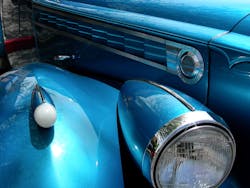Most of us older people are impressed by two things about vehicles today: how much horsepower these modern small engines can make, and how reliable these vehicles have become. This seems to break a rule or law of reliability. Certainly, in the lean manufacturing universe the simplest machine that gets the job done usually wins the day.
You would think reliability and simplicity intuitively go together, but that is not what is happening in the truck and automobile world. Modern vehicles are thousands of times more complicated, yet significantly more reliable.
Style and simplicity
These ideas came to me on a mini-vacation last summer, while visiting a quaint old car museum in Asheville, NC. There were some beautiful cars manufactured between the 1920s to the 1950s. The 1940 Packard in particular was beautiful and smooth, had air conditioning and, I would imagine, it made you feel like you had “made it” driving around town.
From a style point of view, these cars had presence. I got to thinking, how much more fun were these old cars to look at? Not only more fun, but since the mechanisms and engineering were so much simpler, cars were easier to maintain.
Because of their simplicity you could see what you were doing and understand the impact of what you were doing. In a way they were not necessarily easier to repair, they were easier to figure out (which always brings along affection from the mechanical sorts).
The trade-off
Now, look at the reliability of cars today. We’ve traded simplicity and maintainability for reliability and complexity. While I was never a mechanic, as a young’un I occasionally fooled around with my cars. Today, however, I am reluctant to even jump start a dead battery (our other car is a hybrid).
Talking to my children, I don’t hear from them that there is as big of a sub-culture like there used to be of adolescents that work on and tinker with cars, though my kids’ friends do have hobbies of making other things both software- and hardware-related.
We seem to face an important question: How the heck are tomorrow’s technicians going to cope with the technology? I assume the systems will be modular, the diagnostics will be done by the machine and the conclusion of what to swap out will be given to the human.
The future
What do we have to do to jump to the next level of reliability? Will we get there with even more complex vehicles? One of the drivers (pun intended) is optimization.
To optimize for fuel consumption while maximizing horsepower requires enormous computational power acting on data from a suite of sensors. There is no obvious way to simplify that.
It is increasingly clear that things will have to get a lot more complex before we come up for air.
Think of the complications of all-wheel drive, power seats, even power liftgates. These things are more and more essential as vehicle safety and technology advances. The next wave is already here with the sensors, cameras and computational horsepower needed for even basic autonomous driving.
I guess a high demand job will be an autonomous driver technician. Time for school, if we can find one.
Joel Levitt is director of projects for Reliabilityweb.com’s Reliability Leadership Institute. Reliabilityweb.com provides the latest reliability and uptime maintenance news and educational information to help make asset managers, reliability leaders and maintenance professionals safer and more successful. The Reliability Leadership Institute is a community of practice to improve how organizations deliver asset performance through the use of Uptime Elements, a reliability framework
About the Author

Joel Levitt
President, Springfield Resources
Joel Levitt has trained more than 17,000 maintenance leaders from more than 3,000 organizations in 24 countries. He is the president of Springfield Resources, a management consulting firm that services a variety of clients on a wide range of maintenance issues www.maintenancetraining.com. He is also the designer of Laser-Focused Training, a flexible training program that provides specific targeted training on your schedule, online to one to 250 people in maintenance management, asset management and reliability.
